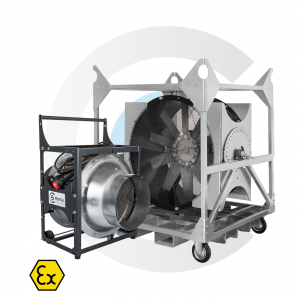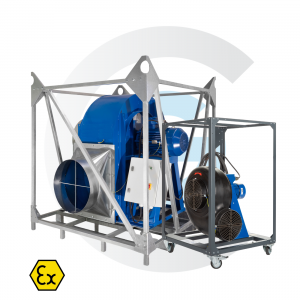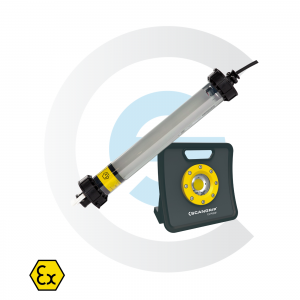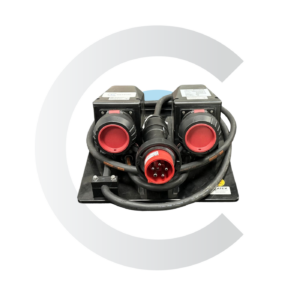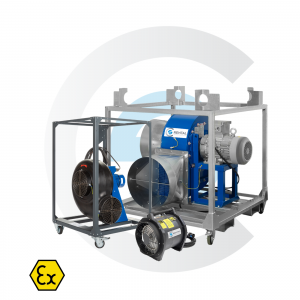Atex / EX
The ATEX guidelines apply to all places where there is a risk of explosion.
The guidelines have a broad scope and include both gas explosion hazard and dust explosion hazard.
Contact met een product specialist?
The ATEX Directive 2014/34/EU provides for regulations regarding products that are used in an explosive environment.
The gas or dust environments are divided into three zones. A separate ATEX certification applies to all zones. Namely: gas zone 0, 1, 2 and the dust zone 20, 21 and 22.
Onze Atex / EX huuroplossingen
The use of explosion-proof equipment in an explosion-hazardous environment is only possible with equipment that is correctly marked. The type plate of the device always bears a clearly legible marking regarding the safety level. The type plate is constructed as follows.
For example: II 2G Ex de IIC T4
(A) II = Group classification as defined in 2014/34/EU
(B) 2G = Zone classification ( 2014/34/EU)
(C) Ex = explosion proof
(D) de = material type of protection (EN IEC 60079-0)
(E) IIC = gas group (or substance group in case of IIIC)
(F) T4 = Temperature class
(A) Equipment groups and categories
There are currently 2 equipment groups:
– Equipment group I concerns all underground (mining) installations;
– Equipment group II concerns all other above-ground installations.
Equipment group II is subdivided into 3 gas groups. The main difference lies in the MESG (Maximum Experimental Safety Gap) for flameproof enclosure and the MIE (Minimum Ignition Energy) for intrinsically safe circuits.
(B) ATEX zone division
In order to determine the extent to which measures are necessary to avoid active ignition sources, potentially explosive areas must be divided into zones according to the regularity and duration of the presence of explosive gas or dust.
| Zone 0 or 20 | Gas or dust constantly present | More than 1000 hours per year |
| Zone 1 or 21 | Gas or dust probably present occasionally | Between 10 hours and 1000 hours per year |
| Zone 2 or 22 | Gas or dust if present for a short time | Less than 10 hours per year |
(C) Ex marking
Explosion prevention mark (EX). Indication that it concerns an explosion-proof product.
(D) Protection mode
There are many ways to protect against ignition. Here are the most commonly used protection methods for gas explosion safety.
| Ex d – flameproof enclosure | NEN – EN – IEC – 60079 – 1 |
| Ex e – erhöhte – increased safety | NEN – EN – IEC – 60079 – 7 |
| Ex p – pressurization – internal overpressure | NEN – EN – IEC – 60079 – 13 |
| Ex i – Intrinsic Safety | NEN – EN – IEC – 60079 – 11 |
| Ex n – non-igniting. Only for category 3G (Zone 2) | NEN – EN – IEC – 60079 – 15 |
| nA = non-sparking, nC = closed construction, nR = limited breathability |
(E) Gas and dust groups
Gas groups
Representative gases or vapors of liquids are:
| Introduction | Attribute | Representative material |
| I | Mining gas = 210 µJ | Methane |
| IIA | Ignition energy > 200 µJ | Propane, butane, kerosene |
| IIB | Ignition energy 60 – 200 µJ | Ethylene, hydrogen sulfide, ethyl ether |
| IIC | Ignition energy 20 – 60 µJ | Hydrogen, acetylene, carbon disulfide |
NB: IIC falls within the range of IIB etc… IIC is the lowest in rank. IIC is therefore the “heaviest” version.
Dust groups
Because more and more EN (Europe Norms) are based on IEC (International Norms), we also have to deal with the new substance groups III within Europe. These are subdivided into IIIA, IIIB and IIIC. The subdivision is characterized as follows:
| Layout | Attribute | Representative material |
| IIIA | Fibers and flakes > 0.5mm | Tobacco, coarse sawdust |
| IIIB | Electrically non-conductive <0.5mm | Milk powder |
| IIIC | Electrically conductive <0.5mm | Graphite powder |
(F) Temperature classes and maximum surface temperature
When a combustible gas mixture or dust cloud comes into contact with an object with a temperature equal to or higher than the ignition temperature of this combustible gas or dust, ignition can take place. For example, heating elements, mechanical drives, electric motors and light bulbs.
Gas explosion-proof equipment is divided into temperature groups or “T-classes”. The material, which is classified in a certain temperature class, may therefore be used for gases with an ignition temperature that is higher than the temperature associated with that group.
Classification principle (standard EN 50 014):
| T1 | Ignition temperature 450°C |
| T2 | Ignition temperature 300°C |
| T3 | Ignition temperature 200°C |
| T4 | Ignition temperature 135°C |
| T5 | Ignition temperature 100°C |
| T6 | Ignition temperature 85°C |
NB: T1 falls within the range of T2 etc… T1 is the lowest in rank. T6 is therefore the ‘heaviest’ version.
Guidelines
As of April 20, 2016, ATEX 95 has been replaced by ATEX 114 (directive 2014/34/EU) and ATEX 137 (directive 1999/92/EC) has a new name, namely ATEX 153. The names of ATEX 114 and ATEX 153 are according to the European Commission only ‘informal’ names. The correct legal names are Directive 2014/34/EU and Directive 1999/92/EC.
All new, explosion-proof equipment and protection systems must comply with the new directive from 20 April 2016.
This mainly affects the manufacturers of explosion-proof equipment and protection systems.
For example, explosion-proof equipment that meets the requirements of ATEX 114 must be marked with the ‘Ex’ sign in a regular hexagon. There is no obligation to have a yellow background here. There will be more product supervision, stricter requirements for importers and new accreditation for ‘notified bodies’.
It is important for users to know that the current ATEX 95 certificates remain valid. However, as soon as explosion-proof equipment or protection systems are modified or renewed, ATEX 114 applies.
The difference between the two directives is that ATEX 114 is applied for the manufacture of installations and products (devices CE directive) and ATEX 153 is applied to the environment, the procedures, the instructions of employees (social directive), both in Ex environments . The aim of this combination of directives is to guarantee the safety and health of employees in areas with a risk of explosion. In addition, ATEX 114 contributes to free trade within the EU for equipment and security systems used in these areas.

